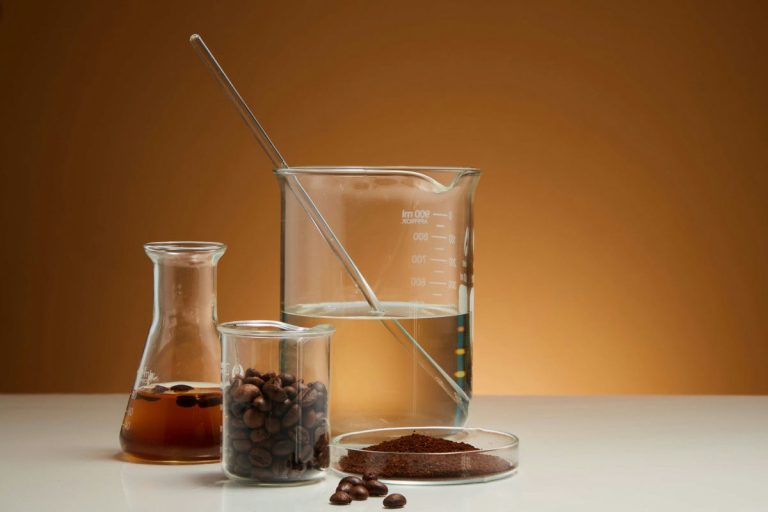 Skip to content
Skip to content

Coffee roasting is an art and science that transforms green and bland beans into a rich sensory experience. Contrary to popular belief, roasting coffee is not just about applying heat. It’s a complex series of chemical transformations that occur due to heat, directly impacting the aromas, flavors, and color of the beans. The two major chemical processes involved in this transformation are the Maillard reaction and caramelization.
The first step of roasting, called ‘drying’, occurs around 100 °C. During this phase, the moisture in the coffee beans evaporates. This step is crucial for preparing the beans for subsequent chemical changes. Then, the temperature continues to rise, reaching specific levels where significant chemical reactions occur. This is where the magic happens: new compounds form, radically altering the flavor and aroma of the coffee.
During the ‘browning’ phase, which begins around 160 °C, the Maillard reactions start, and hundreds of aromatic compounds are created. These compounds are responsible for the varied notes of chocolate, hazelnut, toast, and even fruit that contribute to the complexity of a well-roasted coffee cup.
Beyond 170 °C, the sugars present in the coffee beans begin to caramelize. This often less-known phase adds another dimension of flavors, further enriching the coffee’s aromatic profile.
Roasting is far from being a simple heating operation; it is a precisely orchestrated process. Experienced roasters adjust temperature profiles and the duration of each phase to develop a unique and optimized flavor profile.
The Maillard reaction is a complex interaction that occurs between amino acids and reducing sugars when coffee reaches about 160 °C. Discovered by chemist Louis-Camille Maillard in the early 20th century, this reaction is ubiquitous in cooking and plays a central role in coffee roasting.
The magic of this reaction lies in its ability to generate a stunning variety of aromatic compounds. Over 800 compounds are produced during roasting, each group contributing to a specific layer of the coffee’s aromatic palette. For example, pyridines create nutty nuances, while pyrazines form roasted notes. Aldehydes can give fruity scents, and thiazoles provide spicy touches.
In other words, the Maillard reaction is the beating heart behind the diversity of coffee aromas. But this reaction does not occur randomly. It is influenced by the exact temperature, the duration of the roast, and the chemical composition of the coffee beans. Thus, a Brazilian coffee bean will not react the same way as an Ethiopian bean under the same roasting profile. The botanical variety, growing conditions, and even post-harvest treatment influence the nature and intensity of Maillard reactions.
Managing this reaction to achieve the best possible aromatic profile is a skill that roasters refine over the years. They carefully adjust temperature and constantly monitor the color and smell of the beans to reach the point where the aromas are most developed without burning the beans.
It is also important to note that the Maillard reaction is a continuous process. As the temperature rises, new compounds form, while others break down, thus altering the coffee’s overall flavor and aroma profile. A slight excess of heat or roasting time can lead to a taste that is too bitter or burnt, highlighting the importance of finely and precisely managing this chemical phenomenon.
Caramelization is another fundamental chemical process in coffee roasting, but it is often less understood than the Maillard reaction. Starting at 170 °C, the sugars in the coffee beans begin to break down under the influence of heat, forming additional aromatic compounds while developing a distinct dark brown color. This stage adds sweet, rich, and sometimes slightly bitter notes to the coffee’s flavor profile.
Unlike the Maillard reaction, caramelization does not involve amino acids but focuses exclusively on sugars. The most common sugars present in coffee beans, such as sucrose, glucose, and fructose, undergo a series of chemical transformations that produce compounds such as acetaldehyde, furane, and caramel, each contributing to the overall sensory experience.
The caramelization process follows a specific degradation path known as ‘pyrolytic dehydration’. In simple terms, it is a thermal decomposition that removes water molecules from the sugars, creating a series of new compounds that enhance the taste of the coffee. At higher temperatures, the decomposition can also produce slightly bitter and smoky notes, adding additional depth and complexity to the coffee.
The art of roasting involves balancing these two chemical reactions. Too much caramelization, and the coffee can become too bitter or overloaded with smoky notes. Not enough, and the subtle sweet and rich notes can be lost, leaving an unfinished flavor profile. Expert roasters skillfully balance on this tightrope, using specific temperature profiles and rapid cooling methods to capture the best expression of caramelized compounds.
Another fascinating aspect of caramelization is its interaction with other compounds formed in the Maillard reaction. Together, these processes create a synergy of flavors, resulting in a well-balanced and aromatic cup of coffee. Understanding the separability and complementarity of these reactions offers an infinite playground for experimentation and innovation in the world of roasting.
In summary, caramelization does more than add sweet notes to coffee; it enriches the overall aromatic profile, bringing an extra dimension to the complexity and depth of each cup. By mastering the subtleties of this process, roasters can elevate a simple bean into an exceptional tasting experience.